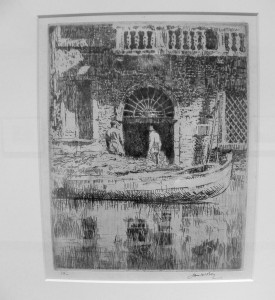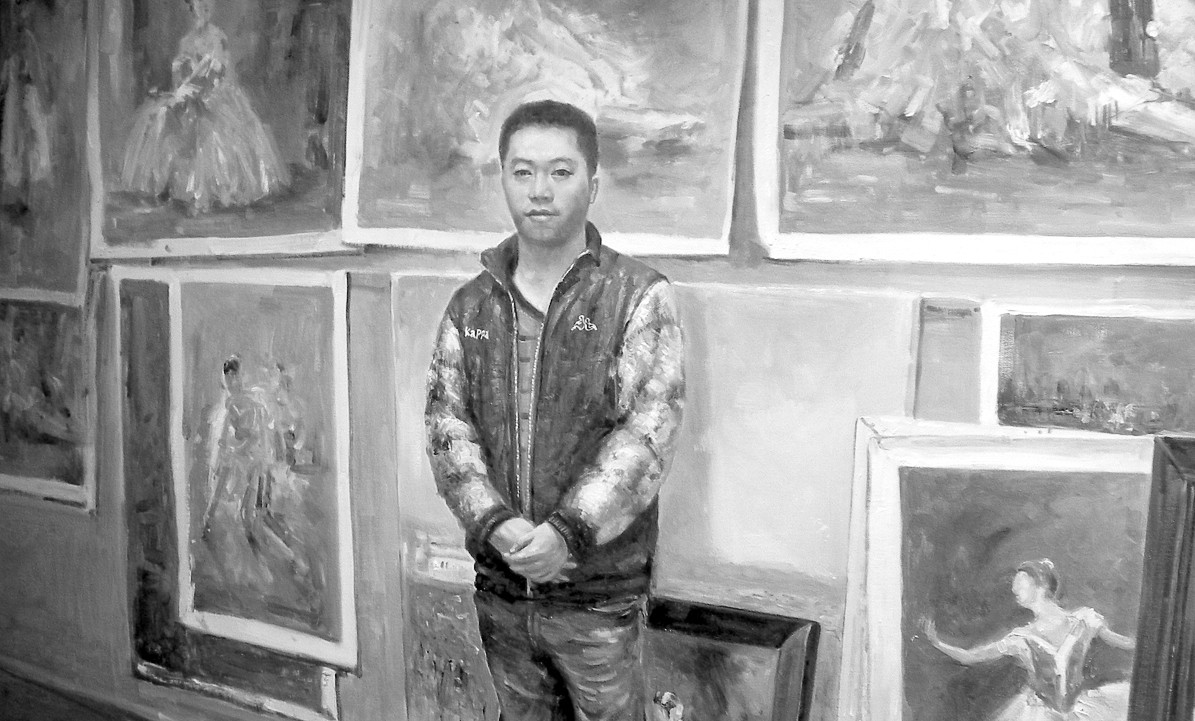The Hillstrom Museum of Art has two new art exhibitions on display. Both Reflections & Undercurrents: Ernest Roth and Printmaking in Venice, 1900-1940 and Now + Then will be on display through April 22, 2012.
Reflections & Undercurrents: Ernest Roth and Printmaking in Venice, 1900-1940
This exhibition features prints that illustrate the picturesque structures of Venice by artists who were instrumental to the etching revival in the late nineteenth century.
These artists were contemporaries of American “aesthete and expatriate” artist James Abbott MacNeill Whistler. The artists represented in the exhibit include: Ernest Roth (1879-1964), John Taylor Arms (1887-1953), Joseph Pennell (1860-1926), Fabio Mauroner (1884-1948) and Whistler himself.
“The exhibit showcases how later artists’ images of Venice reflect earlier artists’ conceptions,” Don Myers, director of the Hillstrom Museum, said.
The exhibition is based on a portion of Eric Denker’s vast art collection. On April 15, 2012, Denker will give a public presentation and lecture on the exhibition, which will take place in the Hillstrom Museum.
“The idea for the show came up when Don called me to ask my advice on a Whistler acquisition for the Hillstrom. I explained I was working on a follow up show of the followers of Whistler in the first half of the twentieth century for Dickinson College and he thought it would be appropriate for Gustavus Adolphus. The focus of the show is the work and interaction [of artists] that followed in Whistler’s footsteps,” Denker said.
“I chose Venice because many of these artists spent considerable time there, attracted by the unique beauty and light and atmosphere of the lagoon city. The interaction of the American and British printmakers working in Italy during this period is previously unexplored. Many unpublished documents are cited including diaries, sketchbooks, manuscripts and journals. Many of the artists also knew Italian printmakers working in Venice and their relationships are likewise underdeveloped in the scholarship on the period,” Denker said.
Trout Gallery owns all of the prints, except for one owned by Gustavus.
“The Museum has an endowment of funds donated for the purpose and it brings in a modest amount of interest proceeds with which the Museum is able from time to time to purchase artworks, which is how the Whistler etching was acquired,” Myers said.
 Reflections and Undercurrentsis organized into categories. The categories help viewers compare and contrast the artwork as well as help viewers compare the artists’ stylistic techniques.
Reflections and Undercurrentsis organized into categories. The categories help viewers compare and contrast the artwork as well as help viewers compare the artists’ stylistic techniques.
“Whistler was interested in art as art, as well as in the experience of aesthetics,” Myers said.
“The Doorway,” [1879-80] is one of the extensively detailed Whistler etchings featured in the exhibition. The piece illustrates another one of Whistler’s “innovative traits, or techniques”—the central motif. According to Denker, this trait exemplifies the avant-garde nature of his Venetian etchings.
Denker writes, “His predilection for emphasizing only the important central elements of the design—while leaving the margins incomplete—is a crucial aspect of the avant-garde nature of his art” (24).
Now + Then
(featuring artwork by current and past studio-art faculty)
“The goal of the exhibit is to highlight faculty artwork, as well as to celebrate the museum’s 150 year history,” Myers said.
The artists represented in the exhibition include Betsy R. Byers, Nicole Roberts Hoiland, Kristen Lowe, Lois Peterson, Dave Ryan, Stanley J. Shetka and Priscilla Briggs.
Currently, Briggs teaches Digital and Darkroom Photography, Video Art and Interactive Media. Two of her works are featured in the exhibition, “Painter #1” (Pan Jin), 2011 and “Painter #5” (Huang Wenlong), 2011. The pieces come from a collection of works that involve Wushipu, which is a neighborhood in China where only production painters occupy the apartment buildings. These painters are commissioned to paint oil paintings for furniture showrooms, hotels and art galleries internationally.
The artistic process, as related to her work in the exhibition, included several steps. First, Briggs took digital photographs of these painters in their home-studios. Then, she commissioned paintings for about the same price as it would have cost her to have them printed via inkjet in the U.S. Once each image had been printed onto canvas, the painters used the digital images that Briggs provided, painting on top of them.
The works are illustrative of “how labor changes the social and environmental landscape in China,” Briggs said.
For instance, they focus on the interiors of retail spaces and the “live-work studios” of the artists. Briggs commented on the unsafe working conditions of these artists because the medium that they use releases dangerous toxins into their living spaces.
Furthermore, her works address labor and the value of art as it relates to “original” artwork. For instance, there is a visible inequality between the amount of labor required of the Wushipu artists and that required of the print studios. Also, “the works entertain the idea of interplay between art and photography as mediums,” Briggs said.
Stanley J. Shetka is another featured innovative artist. He is currently Gustavus faculty. Shetka has two of his works showcased in the exhibition. The first, entitled “Counter Fit,” 2005, is made entirely from Shetkastone.
Shetka invented and patented Shetkastone in the early 1990s. It is one of the only “true” wood replacement materials. It uses recycled paper and other synthetics to make tables, countertops and tiles. It has been featured in a number of respected print media outlets such as The Wall Street Journal, The New York Times and The Washington Post. It has also been featured on Japan’s Asahi News.
Shetka’s inspiration to turn waste into art was an artistic medium interest.
“I don’t believe in art stores,” he said. “I wanted to make my own materials.”
Related to the work, Shetka created “Counter Fit” through the use of two patented processes awarded to him. It took him three years of correspondence with the Federal Reserve in Washington D.C. in order to get permission to use shredded U.S. currency from the Federal Reserve Bank in Minneapolis, Minn., for the creation of Shetkatone.
“I thought it would be a novel idea to use the money, which would have otherwise been burned, to create panels of wood,” Shetka said. Shetka estimated the value of all the currency used to create the work to have been somewhere around 15,000 dollars.
His second work is called the “Book of Life and Death,” 1994. It is part of a collection of works which he calls the Volume of Waste. There are 365 works in the volume and each work is in the shape of a book.
Each book is made from Shetkastone and his own personal accumulation of waste, including cereal boxes, McDonald’s wrappers and trash bags. While some of the books contain holograms, such as the one featured in the exhibit, others contain pressed sculptures.
